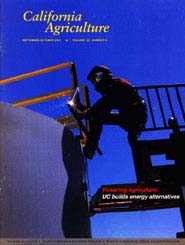All Issues

Powering agriculture: UC builds energy alternatives
Cover:
Long before California's current energy crunch, UC scientists were working with growers and food processors to devise new ways for reducing energy usage in agriculture. At UC Davis, a methane generator called the APS-Digester is under construction that can digest multiple batches of animal manure and plant waste, a significant advance over the old "single-batch" systems; the resulting biogas can be used to produce energy. David R. Bartell welds one of APS-Digester's tanks. Photo by John Stumbos.
September-October 2001
Volume 55, Number 5
Volume 55, Number 5





